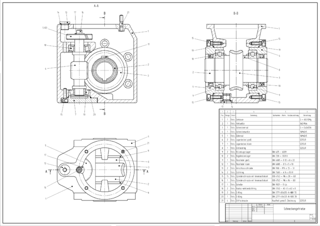Moving Beyond the Bill: Rethinking BOM
Nick Ostdick - April 05, 2016

Go into any chef’s kitchen and you’ll find books of them. They’re scribbled on note cards, torn from magazine articles, printed off from the internet. They’re perhaps just as important as a properly sharpened knife or well cared for sauce pan. We’re talking about recipes - the list and proper amount of ingredients, instructions for preparation, and notes on special techniques. Without recipes, chefs would be lost when creating meals for customers.
 Just as recipes are an important tool for chefs in running a successful lunch or dinner service, so is the Bill of Materials (BOM) for manufacturers and supply chain planners. Without a BOM, companies would be lost when it comes to the overall lifecycle of a product - everything from conception, production, distribution, shipping, and delivery.
Just as recipes are an important tool for chefs in running a successful lunch or dinner service, so is the Bill of Materials (BOM) for manufacturers and supply chain planners. Without a BOM, companies would be lost when it comes to the overall lifecycle of a product - everything from conception, production, distribution, shipping, and delivery.
But in today’s global supply chain landscape, the BOM can and should function as more than just a simple rundown of the necessary parts for production or assembly. Incorporating the BOM into an integrated, intelligent production and supply strategy through implosion or explosion should be a top priority for companies looking for value propositions across all points of the supply stream. Leveraging BOM flexibility and diversity not only helps create greater end-to-end visibility and agility, but can reinvigorate a company’s supply chain on a holistic level.
Defining and redefining BOM
To fully understand where BOM strategy is headed, we must first examine where it’s been. It used to be that BOM was simply a list of raw materials or components necessary for productions. The BOM adequately answered the question ‘What is the product made of?’ by providing manufacturers with a recipe in order to help them best source the materials, select assembly sites, and direct labor in a cost-effective and growth-oriented manner.
 But with the proliferation of such intelligent manufacturing and planning solutions like in-memory databases, cloud computing, and the advancement of technological initiatives like Industry 4.0, BOM strategy has evolved into a key driver in the enhanced digitization of the entire supply process. Through implosion or explosion of the BOM, manufacturers and planners now have the capacity to control the flow of a product from the assembly line to the customer.
But with the proliferation of such intelligent manufacturing and planning solutions like in-memory databases, cloud computing, and the advancement of technological initiatives like Industry 4.0, BOM strategy has evolved into a key driver in the enhanced digitization of the entire supply process. Through implosion or explosion of the BOM, manufacturers and planners now have the capacity to control the flow of a product from the assembly line to the customer.
Today’s powerful intelligent computing systems allow companies to explode or implode BOMs in mere seconds to create accurate, highly-detailed foundations for their manufacturing and supply networks - whereas more traditional processing of BOM explosions can take much longer and lack the flexibility, real-time reporting, and analytic capabilities. The capacity for rapid BOM explosion or implosion allows for changes in production on all levels - from materials to assembly sites to the overall structure of a product - and enhances a company’s ability to see and understand the links between each stage of a product’s production and distribution.
Think back to our chef analogy: When a recipe calls for two cups of unsalted butter, wouldn’t it be beneficial if that recipe also indicated which refrigerator the unsalted butter was in, the compartment where its located inside the refrigerator, the brand of butter, its fat content, and current temperature? Wouldn’t this deeper understanding of the ingredient help our chef move more efficiently throughout the kitchen, use the ingredient in the right way, and create a better end product?
This is the level of insight BOM management can provide, reducing production and supply complexities and eliminating the guess-work often involved with variable-heavy manufacturing and production scenarios.
Benefits of modern BOM functionality
Bill of Materials. Planning BOM. Bill of Process. No matter what you call it, utilizing our new conception of the BOM in a 21st Century production and supply network is not only a key driver in adding value and leveraging growth, but it’s essential in remaining competitive in a rapidly-evolving industry. Implementing BOM management and strategy in conjunction with smart planning and production solutions is vital in the creation of flexible and agile supply networks, but also provide companies with:
- Clearer, more detailed understanding of the flow, movement, and inventory levels of component parts and other materials necessary for production.
- Better identification of optimal sites for assembly, distribution, and delivery.
- Enhanced windows into the overall planning and management of production, and better integration of materials requirement planning (MRP) and enterprise resource planning (ERP) solutions.
- Reduction in production costs and potential for errors - as well as sunk costs and resources - which combat the possibility for supply bottlenecks and disruptions.
In an age of increasingly complex manufacturing and supply logistics, much of which exists on a global plane in disparate locations throughout the world, modern BOM functionality provides this level of enhanced visibility coupled with real-time reporting and data analysis to increase value and productivity, while reducing costs and the potential for lost time and resources in variant rich and mixed production supply streams.
The future of BOM?
As you can see, current application of BOM functionality through implosion, explosion, and other demand planning actions offers companies a wealth of understanding into the components and processes necessary to create and deliver quality products to their customers. The potential for new and more powerful applications of the BOM - particularly as industry trends and technologies like Big Data and Industry 4.0 become more prevalent - is an on-going and increasingly frequent conversation in the manufacturing and supply industry, and the possibility for greater inclusion and functionality in the coming years should take top-billing for managers and planners everywhere.
For the last 15 years, flexis has specialized in simplifying the complexities of BOM explosion and implosion processes utilizing in-memory databases and computing to provide companies with a greater understanding of their production and supply processes.
LATEST POSTS
- Understand Circular Economy in The Manufacturing Industry
- How Can Industry 4.0 IT Integration Be Achieved Smoothly?
- The Significance of Order Sequencing in Discrete Manufacturing
- How to improve your Supply Chain Management: The Power of Control Towers
- Optimizing Human Resource Scheduling in Manufacturing: A Technological Approach



